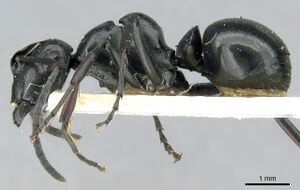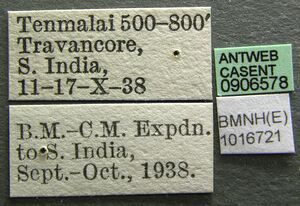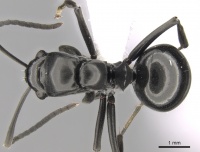Polyrhachis scissa
| Polyrhachis scissa | |
|---|---|

| |
| Scientific classification | |
| Kingdom: | Animalia |
| Phylum: | Arthropoda |
| Class: | Insecta |
| Order: | Hymenoptera |
| Family: | Formicidae |
| Subfamily: | Formicinae |
| Tribe: | Camponotini |
| Genus: | Polyrhachis |
| Subgenus: | Hemioptica |
| Species: | P. scissa |
| Binomial name | |
| Polyrhachis scissa (Roger, 1862) | |
While little is known about the biology of this species, the details provided in the biology section below make this the best known species of the Polyrachis subgenus Hemioptica.
Photo Gallery
Identification
Keys including this Species
Distribution
Distribution based on Regional Taxon Lists
Oriental Region: India, Sri Lanka (type locality).
Presently known from southern India to Sri Lanka.
Distribution based on AntMaps
Distribution based on AntWeb specimens
Check data from AntWeb
Countries Occupied
| Number of countries occupied by this species based on AntWiki Regional Taxon Lists. In general, fewer countries occupied indicates a narrower range, while more countries indicates a more widespread species. |

|
Estimated Abundance
| Relative abundance based on number of AntMaps records per species (this species within the purple bar). Fewer records (to the left) indicates a less abundant/encountered species while more records (to the right) indicates more abundant/encountered species. |

|
Biology
From Dorow and Kohout 1995: Wroughton (1892) noted that the nest was 'very small and composed almost entirely of some spun material', while Forel (1892, 1893) described it as a carton nest in leaf rolls built by gall-inducing insects. However, in his classification of nests, Forel (1909) listed the nest of scissa under 'doubtful nests' and remarked that these seem to be made of pure carton. Escherich (1917) reported a carton nest made of plant particles glued together with glandular substances. Forel (1908) described the habitat of the species as 'under a bamboo at the border of the jungle, isolated on the bamboo, at the border of the forest'. Maschwitz (pers. comm.) observed a nest of P. scissa in a relatively dry monsoon forest close to the shore at Yala National Park, Sri Lanka in March 1977. It was built on a shrub in about 2 m height as a flexible silk web with incorporated detritus around a branch of 2-3 cm in diameter. The nest was about 5 cm long. Maschwitz also collected 2 dealate scissa females at Anuradhapura at the end of January and at the beginning of February 1972. The workers of scissa behave in the manner typical of most Polyrhachis species - in danger they hide below the leaves.
Castes
Images from AntWeb
   
| |
| Worker. Specimen code casent0906578. Photographer Estella Ortega, uploaded by California Academy of Sciences. | Owned by NHMUK, London, UK. |
Males are deposited in the BMNH but have not been described.
Nomenclature
The following information is derived from Barry Bolton's Online Catalogue of the Ants of the World.
- scissa. Hemioptica scissa Roger, 1862a: 240, pl. 1, fig. 12 (w.q.) SRI LANKA. Forel, 1893c: 27 (m.); Wheeler, G.C. & Wheeler, J. 1990b: 757 (l.). Combination in Polyrhachis (Hemioptica): Mayr, 1879: 651; in Hemioptica: Bingham, 1903: 380; Emery, 1925b: 210. See also: Dorow & Kohout, 1995: 100.
Description
Worker
Dorow and Kohout 1995:
Dimensions (lectotype cited first, paralectotype second): TL c. 6.36, 6.61, 7.00-7.21; HL 1.65, 1.78, 1.81-1.93; HW 1.22, 1.26, 1.48-1.50; CI 74, 71, 78-82; SL 1.90, 2.06, 2.15-2.18; SI 156, 163, 145; PW 1.28, 1.33, 1.43-1.47; MTL 1.81, 1.96, 2.09-2.12 (12 measured).
Mandibles with 5 teeth. Clypeus in profile sinuate, slightly concave anteriorly, moderately convex posteriorly with weakly impressed basal margin; anterior margin arcuate with medially situated 'V' shaped minute notch. Frontal carinae prominent with moderately raised lobes; area between them gently excavated. Eyes relatively large, truncate posteriorly (blinkers). Ocelli lacking (relative position of median ocellus marked by a minute shallow depression). Pronotum in front with shallow transverse depression, humeri dentate, continuous posteriorly for short distance as ill defined lateral margins; pronotal dorsum convex, extending posteriorly as a shield which conceals the greater portion of the mesonotal dorsum. Metanotal groove deeply impressed, extending on each side past metathoracic spiracles. Propodeal dorsum convex; anterior margin deeply medially emarginated, projecting forward, partly bridging the furrow (the propodeal dorsum appears to be consistently asymetrical and distinctly twisted to the left in all scissa specimens examined, including types). Posteriorly the propodeal dorsum is separated from declivity by arched, laterally angulated carina; declivity abrupt. Petiole in side view biconvex, armed with a pair of short, acute spines situated on the dorsolateral angles and separated by the transversely convex, acute, medially emarginated dorsal edge of the segment. First gastral tergite with base shallowly truncate.
Mandibles closely shagreened, with piliferous pits. Clypeus, frontal areas of head and occiput finely shagreened with scattered shallow pits; sculptural intensity more distinct laterally, with sides of head rather densely punctate. Lateral branches of mesosoma shagreened, with sculptural intensity markedly decreasing dorsally; mesosomal dorsum very finely, closely shagreened, resulting in peculiar semiopaque effect, quite contrasting with more or less glossy appearance of the rest of the body. Gastral dorsum shagreened with numerous piliferous pits, reflective.
Mandibles with short, semierect hairs. Anterior clypeal margin with a single seta arising from median 'V'-shaped notch; 3 to 4 pairs of setae arise along the midline from clypeus to the occiput. Numerous adpressed and semierect short hairs arise from piliform pits scattered over whole of the body. Gaster on ventral aspect and apex with scattered long hairs.
Black throughout.
Queen
Dorow and Kohout 1995:
Dimensions: TL c. 8.44-8.72; HL 1.96-2.03; HW 1.42-1.50; CI 72-74; SL 2.12-2.28; SI 149-152; PW 1.81-1.93; MTL 2.17-2.34 (2 measured).
The female resembles the worker and, besides the obvious characters identifying full sexuality, differs in lack of the peculiar semiopaque effect of the mesosoma. The mesoscutum, mesoscutellum and propodeal dorsum are regularly shagreened with numerous piliferous pits, reflective.
Type Material
Dorow and Kohout 1995:
Syntype workers, females. Original localities: Sri Lanka (as Ceylon), Berlin Museum für Naturkunde der Humboldt-Universität (2 workers examined); "Ostindien', Musee National d'Histoire Naturelle (3 workers, 2 females - all presumed lost).
Syntypes, 2 workers, one here designated lectotype: two syntype workers of P. scissa (NMHU) were examined by Kohout. Both specimens are in good condition and bear three identical labels reading (1) 'Ceylon Nietner' (on yellow tag), (2) Hemioptica scissa Rog., and (3) 'Type' (on red tag). One specimen also bears two additional labels (1) with printed number '10581', and (2) a handwritten label which reads Hemioptica scissa Rog.*. Examination of other Roger types (e.g. P. ammonoeides, latifrons) suggests that he used asterisks to indicate a particular specimen of the series, much as we would now select the holotype (Kohout, 1994: 135). Accordingly the specimen bearing the label with asterisk is here designated lectotype. The second specimen consequently becomes the paralectotype and both were so labelled.
References
- Bingham, C. T. 1903. The fauna of British India, including Ceylon and Burma. Hymenoptera, Vol. II. Ants and Cuckoo-wasps. London: Taylor and Francis, 506 pp. (page 380, Combination in Hemioptica)
- Dias, R.K.S., Rajapaksa, R.P.K.C. 2017. Geographic records of subfamilies, genera and species of ants (Hymenoptera: Formicidae) in the four climatic zones of Sri Lanka: A review. Journal of Science of the University of Kelaniya Sri Lanka 11, 23-45. (doi:10.4038/josuk.v11i2.7999).
- Dorow, W. H. O.; Kohout, R. J. 1995. A review of the subgenus Hemioptica Roger of the genus Polyrhachis Fr. Smith with description of a new species (Hymenoptera: Formicidae: Formicinae). Zool. Meded. (Leiden) 69: 93-104 (page 100, see also)
- Emery, C. 1925d. Hymenoptera. Fam. Formicidae. Subfam. Formicinae. Genera Insectorum 183: 1-302 (page 210, Combination in Hemioptica)
- Escherich, K .L., 1 917. Die Ameise. Schilderung ihrer Lebensweise. 2nd ed. (1st 1906), 348 pp. Braunschweig.
- Forel, A" 1892. Die Nester der Ameisen: 1-36, figs 1-18. Zurcher & Furrer, Zurich.
- Forel, A. 1893e. Les Formicides de l'Empire des Indes et de Ceylan. Part III. J. Bombay Nat. Hist. Soc. 8: 17-36 (page 27, male described)
- Forel, A., 1908. Fourmis de Ceyian et d'Egypte. Bull. Soc. vaud. Sci. nat. 44:1 -22.
- Forel, A., 1909. Etudes myrmecologiques en 1909. Bull. Soc. vaud. Sci. nat. 45:369-407.
- Mayr, G. 1879. Beiträge zur Ameisen-Fauna Asiens. Verh. K-K. Zool.-Bot. Ges. Wien 28: 645-686 (page 651, Combination in Polyrhachis (Hemioptica))
- Roger, J. 1862a. Einige neue exotische Ameisen-Gattungen und Arten. Berl. Entomol. Z. 6: 233-254 (page 240, pl. 1, fig. 12 worker, queen described)
- Wheeler, G. C.; Wheeler, J. 1990b. Larvae of the formicine ant genus Polyrhachis. Trans. Am. Entomol. Soc. 116: 753-767 (page 757, larva described)
- Wroughton, R.C., 1892. Our ants. Part 1. J. Bombay nat. Hist. Soc. 1 892:13-60.
References based on Global Ant Biodiversity Informatics
- Chapman, J. W., and Capco, S. R. 1951. Check list of the ants (Hymenoptera: Formicidae) of Asia. Monogr. Inst. Sci. Technol. Manila 1: 1-327
- Dias R. K. S. 2002. Current knowledge on ants of Sri Lanka. ANeT Newsletter 4: 17- 21.
- Dias R. K. S. 2006. Current taxonomic status of ants (Hymenoptera: Formicidae) in Sri Lanka. The Fauna of Sri Lanka: 43-52. Bambaradeniya, C.N.B. (Editor), 2006. Fauna of Sri Lanka: Status of Taxonomy, Research and Conservation. The World Conservation Union, Colombo, Sri Lanka & Government of Sri Lanka. viii + 308pp.
- Dias R. K. S., K. R. K. A. Kosgamage, and H. A. W. S. Peiris. 2012. The Taxonomy and Conservation Status of Ants (Order: Hymenoptera, Family: Formicidae) in Sri Lanka. In: The National Red List 2012 of Sri Lanka; Conservation Status of the Fauna and Flora. Weerakoon, D.K. & S. Wijesundara Eds., Ministry of Environment, Colombo, Sri Lanka. p11-19.
- Dias R. K. S., and R. P. K. C. Rajapaksa. 2016. Geographic records of subfamilies, genera and species of ants (Hymenoptera: Formicidae) in the four climatic zones of Sri Lanka: a review. J. Sci. Univ. Kelaniya 11(2): 23-45.
- Donisthorpe H. 1942. Ants from the Colombo Museum Expedition to Southern India, September-October 1938. Annals and Magazine of Natural History (11)9: 449-461.
- Dorow W. H. O.; and R.J. Kohout. 1995. A review of the subgenus Hemioptica Roger of the genus Polyrhachis Fr. Smith with description of a new species (Hymenoptera: Formicidae: Formicinae). Zool. Meded. (Leiden) 69: 93-104
- Emery C. 1886. Saggio di un catalogo sistematico dei generi Camponotus, Polyrhachis e affini. Memorie della Reale Accademia delle Scienze dell'Istituto di Bologna 5: 363-382
- Emery C. 1893. Voyage de M. E. Simon à l'île de Ceylan (janvier-février 1892). Formicides. Annales de la Société Entomologique de France 62: 239-258.
- Emery C. 1901. Ameisen gesammelt in Ceylon von Dr. W. Horn 1899. Deutsche Entomologische Zeitschrift 1901: 113-122.
- Forel A. 1893. Les Formicides de l'Empire des Indes et de Ceylan. Part III. J. Bombay Nat. Hist. Soc. 8: 17-36.
- Forel A. 1909. Études myrmécologiques en 1909. Fourmis de Barbarie et de Ceylan. Nidification des Polyrhachis. Bull. Soc. Vaudoise Sci. Nat. 45: 369-407.
- Forel A. 1911. Ameisen aus Ceylon, gesammelt von Prof. K. Escherich (einige von Prof. E. Bugnion). Pp. 215-228 in: Escherich, K. Termitenleben auf Ceylon. Jena: Gustav Fischer, xxxii + 262 pp.
- Forel, A. 1908. Fourmis de Ceylan et d'Égypte récoltées par le Prof. E. Bugnion. Lasius carniolicus. Fourmis de Kerguelen. Pseudandrie? Strongylognathus testaceus. Bull. Soc. Vaudoise Sci. Nat. 44: 1-22
- Robson Simon Database Polyrhachis -05 Sept 2014




